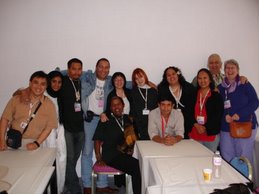By Marty Logan
Updated Dec 6, 2005, 11:32 pm
TUNIS (IPS/GIN) - The Indigenous Navajo people of the southwestern United States are now using the Internet to reconnect to their traditional culture and help improve their communities.
“We used to have a hard time building infrastructure to support economic and community development,” said Ernest Franklin Jr., from the Navajo Nation. That was partly because information about the Navajo Nation’s resources would not be passed on to new leaders of the huge Navajo territory, he told IPS.
What they needed to change that trend, tribal leaders decided, was a communications system to link more than 200,000 people in 110 communities scattered over 27,000 square miles.
“We knew that, if we were to establish a fiber optic cable, it would never get done because of all the red tape of working with the government,” Mr. Franklin said. “But after renting space on a satellite, we were able to hook up all the communities in three months. Then, we created 110 websites—that’s how people learned how to develop their communities.”
The Navajo used the websites to first provide information about planning and community development, which in turn led locals to draw up inventories of resources like land, water, roads and power lines, and finally to draft local governance laws that would empower individual communities to take the lead in rebuilding their lives.
Today, 20 Navajo communities have adopted land-use plans, and 30 more are in progress, Mr. Franklin noted.
“Now, we have communities that are more sustainable, and the people are very proud because they are building them themselves,” he added. “The U.S. government always used to come in and say ‘here’s housing’ or ‘here’s corn, you don’t need to grow your own’—and that created slums and dependence and made people lose respect for themselves and their communities. We want to get back to being self-sustaining.”
To ensure that the information age is not just a passing fad, the Navajo have equipped their 110 community centers with computers and broadband Internet access. High school students on hand to help users are known as “Web Warriors.”
On Nov. 17, the Navajo Nation went global, signing a deal with the WSIS organizer, the United Nations International Telecommunications Union (ITU), that will enable it to spread—what is now known as—“The Navajo Model” to other communities where the roughly 350 million Indigenous people live, starting with Brazil.
Indigenous people are often described as the “poorest of the poor,” and the description holds true for their access to the Internet and other resources developed by the information society. Before the project started five years ago, only 22 percent of the Navajo Nation’s population had access to telephones, 15 percent to computers and 10 percent to the Internet—and that’s in one of the world’s richest countries. The project is now getting people connected fast.
After WSIS I in Geneva in 2003, a group of Indigenous people identified obstacles and challenges to their peoples’ equitable participation in the Information Age. These included poverty, which reduces access to the Internet; fear that the new technologies would force them to conform to one model of living; lack of money to pay the high costs of training; and a shortfall of computer software in Indigenous languages.
A project being endorsed by the Indigenous Caucus in the United States could answer some of those fears. An Aboriginal portal would be set up, “where anyone who wanted to deal with anything Indigenous or learn about anything Indigenous could go,” Indigenous Caucus co-chair Kenneth Deer told IPS.
A portal is an Internet site that typically includes a list of websites on a related topic, along with a search engine. Two such portals exist on Indigenous people’s issues, but governments (Canada and Australia) operate them, pointed out Mr. Deer, a member of the Mohawk nation from Canada.
The proposed international portal would be Indigenous-owned and operated, hosted at a central location, but with support from each of the world’s regions. It could also offer content in local languages (of which roughly 200 exist in the United States alone, though most of them are dying).
Money is the biggest challenge to making it work. “Before this, the problem was one of lack of expertise,” said Mr. Deer. “What we need now is secure funding for at least three to five years.”
Navajo engineers are helping to run the ITU’s television service at the WSIS. “A lot of Indigenous people are scared of technology because they think it’s going to run their lives,” Mr. Franklin said.
But he pointed out that the Navajo have long adopted technologies such as rug-making and silver-smithing, and are now world-renowned practitioners of those arts. “We didn’t invent the Internet, but we brought it into our communities, and are using it to make them stronger.”
© Copyright 2007 FCN Publishing, FinalCall.com
Subscribe to:
Post Comments (Atom)



No comments:
Post a Comment